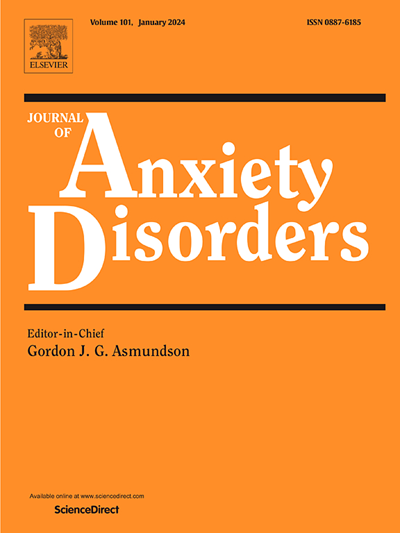Burden of anxiety disorders among older adults aged ≥ 55 years in 204 countries and territories, 1990–2021: A population-based study
IF 4.5
2区 医学
Q1 PSYCHIATRY
引用次数: 0
Abstract
Background
Despite anxiety disorders being a significant public health concern, studies assessing their global burden among older adults are limited. We aimed to analyse trends in the global burden of anxiety disorders in older adults aged ≥ 55 years.
Methods
Data on the incidence and disability-adjusted life-years (DALYs) for anxiety disorders were retrieved from the Global Burden of Diseases, Injuries, and Risk Factors Study (GBD) 2021. Temporal trends were quantified using estimated annual percentage changes.
Results
In 2021, global DALYs for anxiety disorders were estimated at 8.21 million (95 % UI 5.62–11.48 million), nearly 2.5 times higher than in 1990, with an age-standardised rate of 552.7 DALYs (95 % UI 378.1–772.5) per 100,000 population. Between 1990 and 2021, the age-standardised DALY rate (ASDR) remained stable (−0.05 % [95 % CI −0.16–0.05]), with minimal differences between men (0.04 % [−0.05–0.12]) and women (−0.08 % [−0.21–0.05]). The 55–59 age group showed the highest ASDR (538.5 [361.3–767.7] per 100,000 population). The highest increases in ASDR were observed in the low-middle (0.15 % [0.03–0.28]) and low sociodemographic index regions (0.09 % [0.02–0.15]). The regions with the highest ASDRs were Latin America, Western Europe, and High-income North America.
Conclusion
While global trends in anxiety disorders among older adults remained stable, the total burden increased significantly, with marked regional disparities. Tailored mental health interventions, early detection, and treatment in primary care are essential to reduce the future burden of anxiety disorders in older adults, especially in low and middle-income countries.
1990-2021年204个国家和地区年龄≥ 55岁老年人焦虑症负担:一项基于人群的研究
尽管焦虑症是一个重要的公共卫生问题,但评估老年人全球负担的研究有限。我们的目的是分析年龄≥ 55岁的老年人全球焦虑症负担的趋势。方法从全球疾病、伤害和风险因素负担研究(GBD) 2021中检索焦虑症的发病率和残疾调整生命年(DALYs)数据。使用估计的年百分比变化来量化时间趋势。结果2021年,全球焦虑症DALYs估计为821万(95 % UI 562 - 1148万),比1990年高出近2.5倍,年龄标准化率为每10万人552.7 DALYs(95 % UI 378.1-772.5)。1990年至2021年间,年龄标准化DALY率(ASDR)保持稳定(- 0.05 %[95 % CI - 0.16-0.05]),男性(0.04 %[- 0.05 - 0.12])和女性(- 0.08 %[- 0.21-0.05])之间的差异极小。55 ~ 59岁人群ASDR最高,为538.5[361.3 ~ 767.7]/ 10万人。ASDR在中低(0.15 %[0.03-0.28])和低社会人口指数地区(0.09 %[0.02-0.15])的增幅最大。asdr最高的地区是拉丁美洲、西欧和高收入的北美。结论尽管全球老年人焦虑障碍趋势保持稳定,但总体负担明显增加,且地区差异明显。量身定制的精神卫生干预措施、早期发现和初级保健治疗对于减轻老年人焦虑症的未来负担至关重要,特别是在低收入和中等收入国家。
本文章由计算机程序翻译,如有差异,请以英文原文为准。
求助全文
约1分钟内获得全文
求助全文
来源期刊

Journal of Anxiety Disorders
Multiple-
CiteScore
16.60
自引率
2.90%
发文量
95
期刊介绍:
The Journal of Anxiety Disorders is an interdisciplinary journal that publishes research papers on all aspects of anxiety disorders for individuals of all age groups, including children, adolescents, adults, and the elderly. Manuscripts that focus on disorders previously classified as anxiety disorders such as obsessive-compulsive disorder and posttraumatic stress disorder, as well as the new category of illness anxiety disorder, are also within the scope of the journal. The research areas of focus include traditional, behavioral, cognitive, and biological assessment; diagnosis and classification; psychosocial and psychopharmacological treatment; genetics; epidemiology; and prevention. The journal welcomes theoretical and review articles that significantly contribute to current knowledge in the field. It is abstracted and indexed in various databases such as Elsevier, BIOBASE, PubMed/Medline, PsycINFO, BIOSIS Citation Index, BRS Data, Current Contents - Social & Behavioral Sciences, Pascal Francis, Scopus, and Google Scholar.
 求助内容:
求助内容: 应助结果提醒方式:
应助结果提醒方式:


